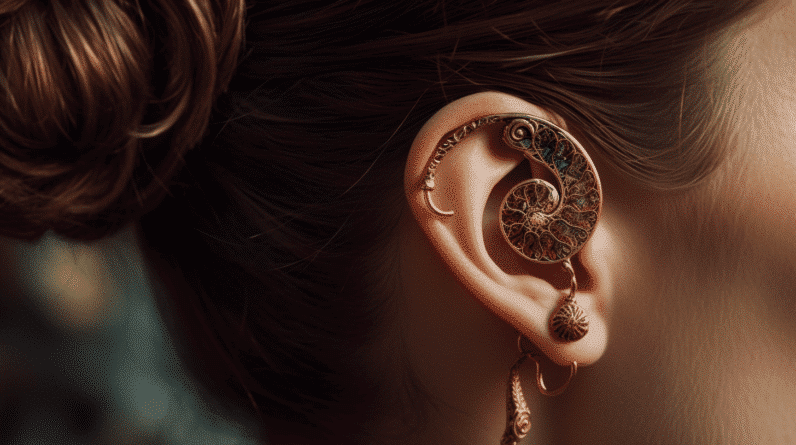
We may earn money or products from the companies mentioned in this post.
As an Amazon Associate I earn from qualifying purchases.
Ever thought your heartbeat had a soundtrack? Pulsatile Tinnitus might just be that peculiar melody. Yet, the real showstopper here could be something you’ve probably never heard of – Eustachian Tube Dysfunction (ETD).
What is Pulsatile Tinnitus?
You’ve heard of regular tinnitus— never-ending ringing in the ears. Now meet its syncopated cousin, Pulsatile Tinnitus. This form of tinnitus bestows upon you the unexpected honor of hearing your own heartbeat. Fascinating, for sure, but potentially problematic. If you notice thumping, whooshing, or other rhythmic noises in your ears that align with your heartbeat, you might be a member of the pulsatile tinnitus club.
The Unsung Hero of Your Ear: The Eustachian Tube
Within our ears, there’s an unsung hero that tirelessly works to maintain balance and regulate pressure. Meet the Eustachian Tube, a small but vital channel connecting the middle ear to our throat and nasal cavity. Now, what if this understated star began to falter? An underperforming Eustachian Tube can lead to Eustachian Tube Dysfunction. This, in turn, might just be the underlying cause of your pulsatile tinnitus.
Why Does my Pulsatile Tinnitus Come and Go?
Ever feel like your pulsatile tinnitus has a mind of its own? One day, it’s there, following your heartbeat like a loyal sidekick. The next, it vanishes. This merry-go-round of symptoms could indicate Intermittent Pulsatile Tinnitus, a phenomenon often linked to the mysteries of Eustachian Tube Dysfunction. Let’s venture into this tantalizing riddle and see whether it holds the answer to your pulsatile enigma.
Pulsatile Tinnitus Goes Solo: Is Eustachian Tube Dysfunction Behind the One-Ear Symphony?
When your pulsatile tinnitus plays in just one ear, it’s time to give Eustachian Tube Dysfunction a hard look. Odd as it appears, ETD could indeed force this one-sided concert. So, you’re probably not imagining the constant thumping in your right ear while your left enjoys blissful silence. To explore this uneven rhythm of your heart’s drumming, stroll over to this corner of my website. Let’s dive into the asymmetrical soundscape of pulsatile tinnitus.
The Orchestra of Influences Behind Pulsatile Tinnitus
Like a grand symphony, multiple factors join to play the pulsatile tinnitus tune, each with its unique melody. But let’s focus on three critical players: earwax buildup, anemia, and our seasonal guest, allergies. As banal as it seems, built-up earwax could get the pulsatile tinnitus ball rolling. A crew of crammed cerumen clumsily hitting against your eardrum – far from a symphony.
Then, there’s anemia. You might not relate a dearth of red blood cells to pulsatile tinnitus, but they’re more connected than you’d guess. With anemic blood humming along your blood vessels, it’s possible to hear that unsettling rhythm.
Lastly, never underestimate sneaky allergies as a conductor of the pulsatile tinnitus orchestra. Swelling and congestion can put unwanted pressure on your middle ear, pumping up that inner drumroll.
All Roads Lead to Relief: Treatment Avenues For Eustachian Tube Dysfunction-Induced Pulsatile Tinnitus
Tired of the non-stop music? Here’s the good news: Eustachian Tube Dysfunction-driven pulsatile tinnitus isn’t a life sentence. Welcome to the realm of options, where surgical and non-surgical treatments form two clear paths that could lead you towards silence. A sneak peek into these treatments? You can unravel the step-by-step guide to an auditory utopia by heading here. Treatment will undoubtedly depend on your personal hearing journey, so putting yourself in the hands of seasoned professionals could be music to your ears, in this case – silence.
How Lifestyle Throws a Wrench in the Works of Pulsatile Tinnitus
Ever wondered how your nightly glass of wine, your morning jolt of caffeine, or even dry, arid weather might hit the wrong note with pulsatile tinnitus? Well, they may not take center stage, but they sure contribute to the off-beat rhythm in your ears.
Drinking alcohol, for instance, causes dehydration that exacerbates Eustachian Tube Dysfunction symptoms. If your pulsatile tinnitus amplifies after your favorite merlot, that’s not a coincidence. Similarly, having your expresso sends a fresh wave of caffeine rushing through you, increasing blood pressure and intensifying the pulsing soundtrack. Ever noticed your pulsatile tinnitus flares up during allergy season? Sinus issues could be jamming along with your tinnitus. So, keeping a tab on these factors could hit the right notes for your ear health.
Pulsatile Tinnitus SOS: Your Guide to the Right Healthcare Professional
The journey with pulsatile tinnitus may feel like you’re stuck on a rickety rollercoaster, navigating twists and bends in the dark. But lighting up this ride is just a matter of finding the right tour guide, or for our metaphor’s sake, the right healthcare professional. Wondering who to reach out to? The answer awaits in the given link!
Finale: The Chronicles of Pulsatile Tinnitus and Eustachian Tube Dysfunction
With a journey as tumultuous as pulsatile tinnitus paired with Eustachian Tube Dysfunction, finding quiet may seem wishful thinking. But with accurate information, methodical examination of the influences, and consulting the right experts, you have a fighting chance. So, take a deep breath, wear your headphones, and let’s march to the beat of your own drum.
Pulsatile Tinnitus Eustachian Tube Dysfunction - Frequently Asked Questions (FAQs)
What is pulsatile tinnitus?
Pulsatile tinnitus is a type of tinnitus characterized by hearing rhythmic noises in the ears that align with the individual’s heartbeat. It can manifest as thumping, whooshing, or other rhythmic sounds and may be indicative of an underlying issue.
What is Eustachian tube dysfunction?
Eustachian tube dysfunction (ETD) refers to a condition where the Eustachian tube, a vital channel connecting the middle ear to the throat and nasal cavity, doesn’t function properly. ETD can disrupt the balance and pressure regulation within the ear and may contribute to pulsatile tinnitus.
Why does pulsatile tinnitus come and go?
Pulsatile tinnitus that comes and goes intermittently is often referred to as intermittent pulsatile tinnitus. This phenomenon can be associated with Eustachian tube dysfunction. The article explores this intriguing aspect and delves into its potential connection with pulsatile tinnitus.
Can Eustachian tube dysfunction cause one-sided pulsatile tinnitus?
Yes, Eustachian tube dysfunction can indeed be responsible for one-sided pulsatile tinnitus. If you experience pulsatile tinnitus in only one ear while the other remains unaffected, it’s essential to consider ETD as a possible cause. The article examines this asymmetrical aspect of pulsatile tinnitus in more detail.
Are there effective treatments for Eustachian tube dysfunction-induced pulsatile tinnitus?
Yes, there are treatment options available for pulsatile tinnitus caused by Eustachian tube dysfunction. The article outlines both surgical and non-surgical avenues for finding relief. However, it’s crucial to consult with healthcare professionals who can assess your specific situation and provide personalized treatment recommendations.
Amazon and the Amazon logo are trademarks of Amazon.com, Inc, or its affiliates.
Related posts:
- Unlocking the Mystery of Ear Infection Pulsatile Tinnitus: Causes, Symptoms, and Revolutionary Treatments
- Unraveling the Mystery of Left Ear Ringing: Medical Causes, Spiritual Significance, and Effective Solutions
- The Cold Reality: Can a Simple Cold Ignite the Rhythms of Pulsatile Tinnitus?
- Ear Crystals Exposed: The Startling Link to Persistent Tinnitus








